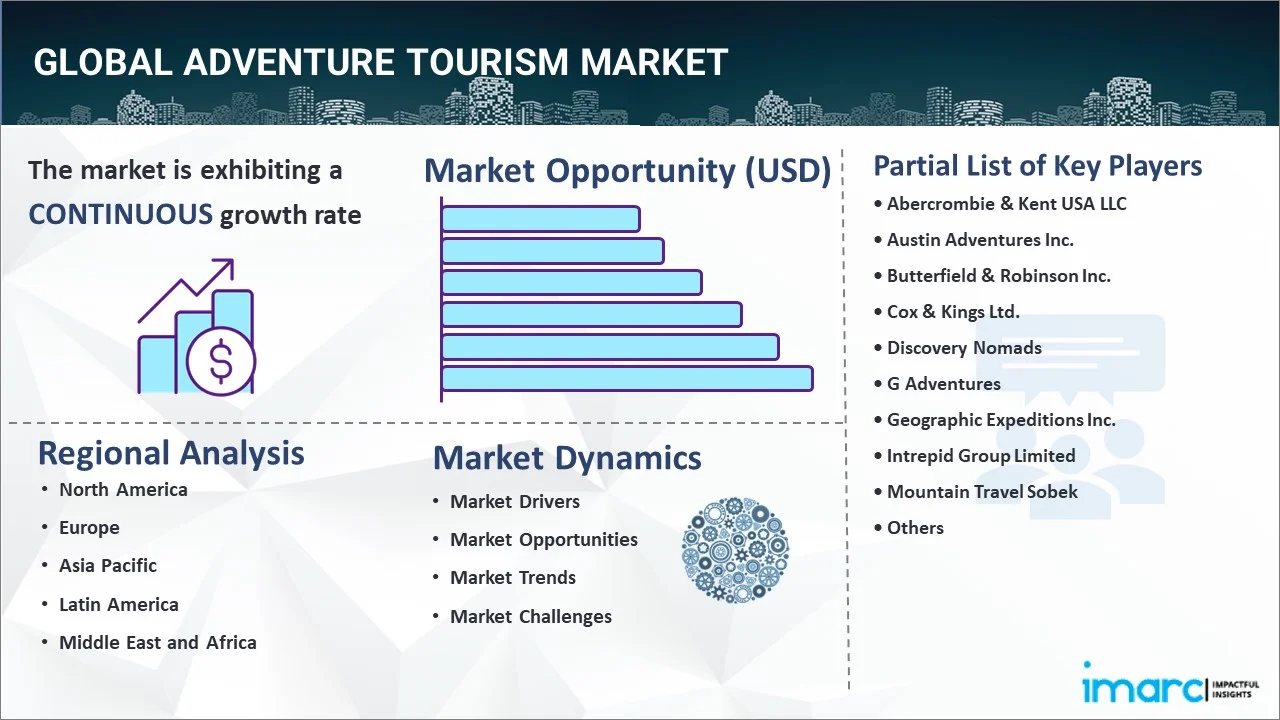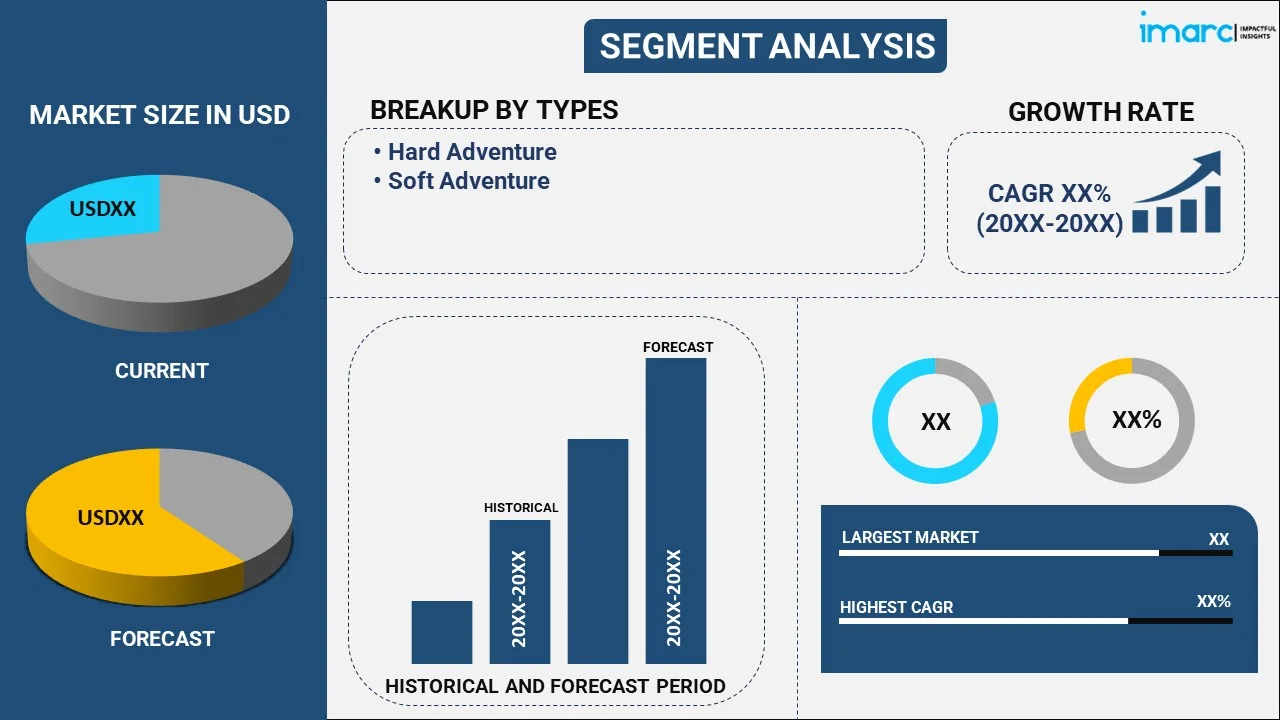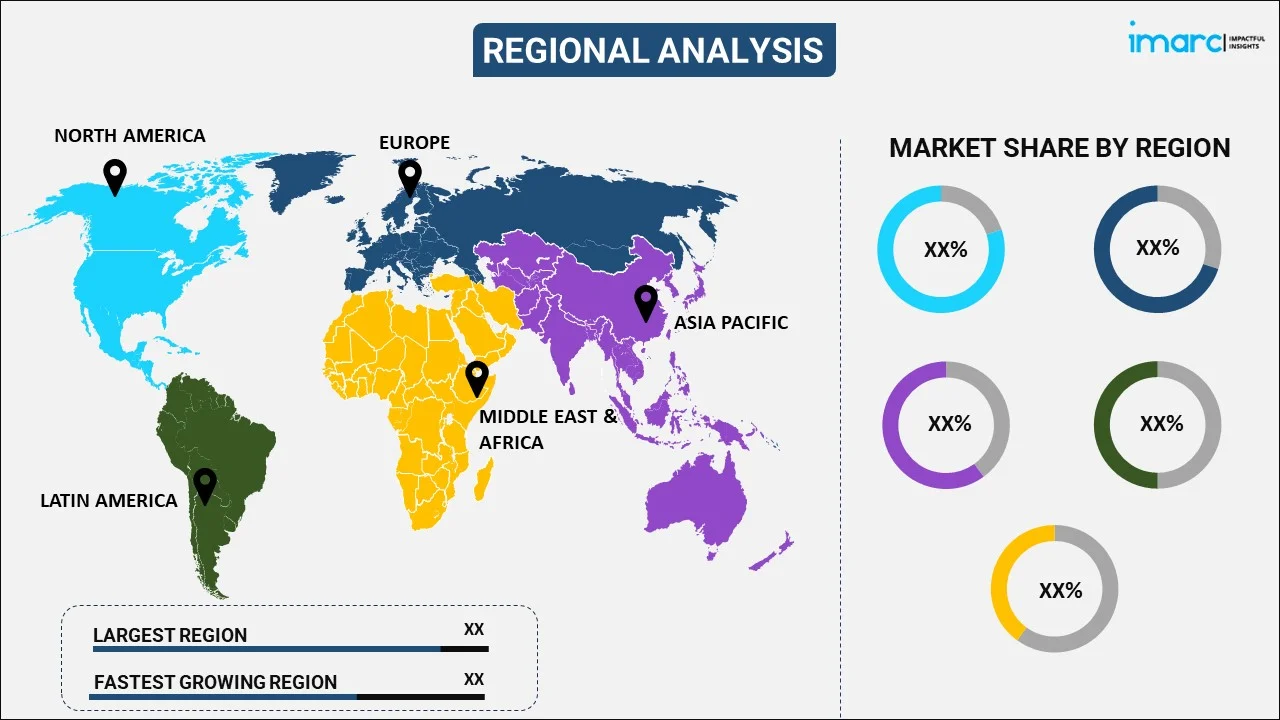
Adventure Tourism Market Report by Type (Hard Adventure, Soft Adventure), Activity (Land-based Activity, Water-based Activity, Air-based Activity), Age Group (Below 30 Years, 30–41 Years, 42–49 Years, 50 Years and Above), Sales Channel (Travel Agent, Direct), and Region 2025-2033
Global Adventure Tourism Market Size and Outlook:
The global adventure tourism market size reached USD 476.0 Billion in 2024. Looking forward, IMARC Group expects the market to reach USD 1,824 Billion by 2033, exhibiting a growth rate (CAGR) of 16.1% during 2025-2033. Surging popularity of authentic and individualized travel experiences is significantly propelling the market demand. According to the UN Tourism, a projected 285 million travellers toured internationally in Q1 2024, a growth of 20% over Q1 2023. The Middle East witnessed a robust relative growth, with international arrivals exceeding over 36% of pre-pandemic levels.
|
Report Attribute
|
Key Statistics
|
|---|---|
|
Base Year
|
2024
|
|
Forecast Years
|
2025-2033
|
|
Historical Years
|
2019-2024
|
|
Market Size in 2024
|
USD 476.0 Billion |
|
Market Forecast in 2033
|
USD 1,824 Billion |
| Market Growth Rate 2025-2033 | 16.1% |
Adventure tourism is an evolving segment within the tourism industry that focuses on travel experiences centered around adventure activities. These activities often involve physical exertion, interaction with nature, and excitement, frequently taking place in natural or remote settings. Adventure tourism comprises hiking, mountain climbing, rafting, and scuba diving, among others. The appeal of adventure tourism is in the adrenaline rush and the opportunity for personal growth, skill development, and a deepened respect for natural and cultural environments. This tourism category is increasingly gaining attention for its potential to promote sustainable practices, as it often relies on pristine natural landscapes and, therefore, has an interest in their preservation.

The increasing consumer preference for experiential travel over material possessions is leading more people to seek unique, off-the-beaten-path experiences, thereby driving the demand for adventure tourism. In addition to this, the rise of social media platforms is acting as another major factor influencing the adventure tourism market, as they provide travellers with a platform to share and showcase their experiences, thereby inadvertently promoting the thrill and beauty of adventure activities. Moreover, significant advancements in technology, such as booking platforms, mobile apps, and digital payment options, are simplifying the planning and execution of adventure trips, thereby lowering barriers to entry for consumers, which is contributing to the market growth. Besides this, the growing awareness of the physical and mental health benefits such as ranging from improved cardiovascular health to stress reduction of outdoor activities like hiking, kayaking, and mountain climbing is encouraging increased participation in adventure tourism. Furthermore, supportive government initiatives aimed at promoting tourism are contributing to the adventure tourism market growth.
Adventure Tourism Market Trends/Drivers:
Increasing consumer desire for experiential travel
The shift towards valuing experiences over material goods is profoundly impacting the travel and tourism industry. In the context of adventure tourism, this manifests as a growing consumer appetite for trips that offer more than just leisure or sightseeing as they seek transformative experiences. Adventure activities, whether it’s trekking through untamed wilderness or diving in exotic marine environments, provide these transformative experiences by challenging individuals both physically and emotionally. This craving for substantive experiences is not just a fleeting trend; it is substantiated by various consumer surveys and market studies. The experiences sought often encourage personal growth, offer novel perspectives, and facilitate meaningful human connections. As a result, travel agencies, tour operators, and destination marketers are recognizing this shift and are consequently expanding their adventure tourism offerings to meet the growing demand.
The impact of social media
Social media platforms have emerged as strong tools for influencing consumer behavior, and the adventure tourism market is no exception. Moreover, social media platforms are proliferated with travel content, showcasing both mainstream and off-the-beaten-path experiences. Adventure tourism activities, which are inherently photogenic and shareable, frequently go viral, creating a sort of online 'word-of-mouth' effect. Besides this, social media also serves as a platform for reviews and recommendations, building credibility and trust among potential adventurers. Furthermore, the sense of community fostered by these platforms can inspire individuals to undertake activities they may not have otherwise considered. Businesses within the adventure tourism sector are increasingly leveraging social media for marketing, understanding its role in shaping consumer preferences and expectations.
Advancements in technology
Ongoing technological innovations are making it significantly easier for consumers to access the adventure tourism market. Booking platforms and mobile apps streamline the planning process, offering consumers an array of options tailored to their specific interests and capabilities. These platforms often come equipped with features like real-time availability, customer reviews, and secure payment gateways, thereby reducing the logistical challenges traditionally associated with adventure tourism. Additionally, technology is also improving safety measures global positioning system (GPS) tracking, advanced weather forecasting, and emergency communication systems are making adventure activities more secure, thus reducing one of the significant barriers that potential travelers might face. The adoption of these technologies is acting as a catalyst enabling more people to participate in adventure tourism activities.
Adventure Tourism Industry Segmentation:
IMARC Group provides an analysis of the key trends in each segment of the market report, along with forecasts at the global, regional, and country levels from 2025-2033. Our report has categorized the market based on type, activity, age group, and sales channel.
Breakup by Type:

- Hard Adventure
- Soft Adventure
Soft adventure accounts for the majority of the market share
The report has provided a detailed breakup and analysis of the market based on the type. This includes hard adventure and soft adventure. According to the report, soft adventure represented the largest segment.
Soft adventure activities, such as hiking, cycling, and snorkeling, tend to be more accessible to a broad range of people, including those with varying fitness levels and ages. This inclusivity enlarges the market demographic, thereby boosting the market growth. Concurrent with this, these activities usually require less specialized equipment and training, making them more convenient and cost-effective for the average traveler, which, in turn, is strengthening the market growth. Furthermore, soft adventure tourism often poses fewer risks compared to hard adventure activities, such as rock climbing or white-water rafting, making it more appealing to safety-conscious travelers, thus creating a favorable outlook for market expansion.
Breakup by Activity:
- Land-based Activity
- Water-based Activity
- Air-based Activity
Land-based activity holds the largest share in the industry
A detailed breakup and analysis of the market based on the activity has also been provided in the report. This includes land-based, water-based, and air-based activities. According to the report, land-based activity accounted for the largest market share.
The accessibility of land-based activities like hiking, trekking, and mountain biking is generally higher compared to water-based or air-based activities. These activities often require less specialized equipment and training, making them more approachable for a broader audience. In confluence with this, many popular tourist destinations are better equipped to offer land-based activities due to their geographical features, such as mountain ranges, forests, and deserts. This widespread availability boosts participation rates, aiding in market expansion. Another contributing factor is the versatility of land-based adventures, which can cater to varying skill levels and preferences, thereby attracting a diverse range of participants.
Breakup by Age Group:
- Below 30 Years
- 30–41 Years
- 42–49 Years
- 50 Years and Above
30–41 years represent the leading market segment
The report has provided a detailed breakup and analysis of the market based on the age group. This includes below 30 years, 30–41 years, 42–49 years, and 50 years and above. According to the report, 30–41 years represented the largest segment.
Individuals in this age range often find themselves in a life stage conducive to adventure travel. They are typically past the stage of early career uncertainties and family planning, which can limit travel opportunities. Consequently, they have more disposable income and time to devote to adventurous pursuits, which is presenting lucrative opportunities for market expansion. In addition to this, this demographic cohort places a high value on experiences and personal growth, propelling the market forward. Adventure tourism offers opportunities for self-discovery, challenge, and pushing boundaries, aligning with the values and desires of this age group.
Breakup by Sales Channel:
- Travel Agent
- Direct
Direct exhibits a clear dominance in the market
The report has provided a detailed breakup and analysis of the market based on the sales channel. This includes travel agent and direct. According to the report, direct represented the largest segment.
Direct sales channels provide tour operators and adventure companies with greater control over their offerings, allowing them to customize experiences to the specific needs and preferences of their target audience. This customization enhances customer satisfaction and loyalty, which is aiding in market expansion. Moreover, direct channels enable these businesses to maximize their profit margins by eliminating third-party commissions and fees associated with intermediaries. This cost-effectiveness allows for competitive pricing and attractive package deals, drawing in more customers, thereby influencing the market growth. With the growing emphasis on authenticity and unique experiences in adventure tourism, direct sales channels are well-positioned to continue their dominance in this market.
Breakup by Region:

- North America
- United States
- Canada
- Asia-Pacific
- China
- Japan
- India
- South Korea
- Australia
- Indonesia
- Others
- Europe
- Germany
- France
- United Kingdom
- Italy
- Spain
- Russia
- Others
- Latin America
- Brazil
- Mexico
- Others
- Middle East and Africa
Europe leads the market, accounting for the largest adventure tourism market share
The market research report has also provided a comprehensive analysis of all the major regional markets, which include North America (the United States and Canada); Asia Pacific (China, Japan, India, South Korea, Australia, Indonesia, and others); Europe (Germany, France, the United Kingdom, Italy, Spain, Russia, and others); Latin America (Brazil, Mexico, and others); and the Middle East and Africa. According to the report, Europe accounted for the largest market share.
Europe's dominance in the adventure tourism market can be attributed to the continent's rich diversity of landscapes and environments providing an ideal playground for a wide range of adventure activities, from alpine skiing in the Swiss Alps to hiking in the Scottish Highlands. Furthermore, the geographical diversity of Europe attracts adventure seekers from around the world, creating a favorable outlook for market expansion. In line with this, Europe's well-developed infrastructure, including extensive trail networks, well-maintained national parks, and efficient transportation systems, makes it convenient for travelers to access and enjoy these adventure experiences. Apart from this, Europe's strong commitment to sustainability and environmental conservation aligns with the responsible and eco-friendly ethos often associated with adventure tourism, further enhancing its appeal.
Competitive Landscape:
The global adventure tourism market boasts a dynamic and competitive landscape, characterized by a mix of established players and emerging entrants striving to cater to the growing demand for adventurous and experiential travel. The leading players in the adventure tourism market are actively shaping the industry through strategic initiatives. They are also emphasizing sustainability, incorporating eco-friendly practices and responsible tourism principles to minimize their environmental impact. Moreover, these key players are investing in technology, using digital platforms to streamline bookings, enhance customer experiences, and provide real-time updates to adventurers. Collaborations with local communities and indigenous groups are becoming more common, ensuring that the benefits of adventure tourism are shared with the destinations' residents.
The market research report has provided a comprehensive analysis of the competitive landscape. Detailed profiles of all major companies have also been provided. Some of the key players in the market include:
- Abercrombie & Kent USA LLC
- Austin Adventures Inc.
- Butterfield & Robinson Inc.
- Cox & Kings Ltd.
- Discovery Nomads
- G Adventures
- Geographic Expeditions Inc.
- Intrepid Group Limited
- Mountain Travel Sobek
- Recreational Equipment Inc.
- ROW Adventures
- TUI AG
(Please note that this is only a partial list of the key players, and the complete list is provided in the report.)
Recent Developments:
- In April 2023, Abercrombie & Kent, luxury travel company launched a new expedition cruise that will give guests a chance to venture to Earth's northernmost point.
- In December 2022, Active Adventures and Austin Adventures launched their revamped brands, driven by feedback from guests, employees, and partners, with a focus on delivering inspiring global adventure travel experiences.
- In April 2021, Trivago, a leading global accommodation search platform, collaborated with TUI Group, the world’s leading tourism group, to provide trivago users with direct access to more than 55,000 excursions, activities and tickets.
Adventure Tourism Market Report Scope:
| Report Features | Details |
|---|---|
| Base Year of the Analysis | 2024 |
| Historical Period | 2019-2024 |
| Forecast Period | 2025-2033 |
| Units | Billion USD |
| Scope of the Report | Exploration of Historical Trends and Market Outlook, Industry Catalysts and Challenges, Segment-Wise Historical and Future Market Assessment:
|
| Types Covered | Hard Adventure, Soft Adventure |
| Activities Covered | Land-based Activity, Water-based Activity, Air-based Activity |
| Age Groups Covered | 30 Years, 30–41 Years, 42–49 Years, 50 Years and Above |
| Sales Channels Covered | Travel Agent, Direct |
| Regions Covered | Asia Pacific, Europe, North America, Latin America, Middle East and Africa |
| Countries Covered | United States, Canada, Germany, France, United Kingdom, Italy, Spain, Russia, China, Japan, India, South Korea, Australia, Indonesia, Brazil, Mexico |
| Companies Covered | Abercrombie & Kent USA LLC, Austin Adventures Inc., Butterfield & Robinson Inc., Cox & Kings Ltd., Discovery Nomads, G Adventures, Geographic Expeditions Inc., Intrepid Group Limited, Mountain Travel Sobek, Recreational Equipment Inc., ROW Adventures and TUI AG, etc. |
| Customization Scope | 10% Free Customization |
| Post-Sale Analyst Support | 10-12 Weeks |
| Delivery Format | PDF and Excel through Email (We can also provide the editable version of the report in PPT/Word format on special request) |
Key Benefits for Stakeholders:
- IMARC’s industry report offers a comprehensive quantitative analysis of various market segments, historical and current market trends, market forecasts, and dynamics of the adventure tourism market from 2019-2033.
- The research report provides the latest information on the market drivers, challenges, and opportunities in the global adventure tourism market.
- The study maps the leading, as well as the fastest-growing, regional markets. It further enables stakeholders to identify the key country-level markets within each region.
- Porter's five forces analysis assist stakeholders in assessing the impact of new entrants, competitive rivalry, supplier power, buyer power, and the threat of substitution. It helps stakeholders to analyze the level of competition within the adventure tourism market industry and its attractiveness.
- Competitive landscape allows stakeholders to understand their competitive environment and provides an insight into the current positions of key players in the market.
Key Questions Answered in This Report
The global adventure tourism industry was valued at USD 476.0 Billion in 2024.
We expect the global adventure tourism market to exhibit a CAGR of 16.1% during 2025-2033.
The rising demand for authentic and personalized traveling experience, along with the growing consumer awareness towards the adverse impact of conventional tourism, such as soil erosion, increasing pollution levels, natural habitat loss, etc., is primarily driving the global adventure tourism market.
The sudden outbreak of the COVID-19 pandemic had led to the implementation of stringent lockdown regulations across several nations, resulting in the temporary halt in numerous recreational travel activities, thereby negatively impacting the global market for adventure tourism.
Based on the type, the global adventure tourism market has been segmented into hard adventure and soft adventure, where soft adventure currently holds the majority of the total market share.
Based on the activity, the global adventure tourism market can be divided into land-based activity, water-based activity, and air-based activity. Currently, land-based activity exhibits a clear dominance in the market.
Based on the age group, the global adventure tourism market has been categorized into below 30 years, 30–41 years, 42–49 years, and 50 years and above. Among these, 30–41 years currently account for the largest market share.
Based on the sales channel, the global adventure tourism market can be bifurcated into travel agent and direct. Currently, direct exhibits a clear dominance in the market.
On a regional level, the market has been classified into North America, Asia-Pacific, Europe, Latin America, and Middle East and Africa, where Europe currently dominates the global market.
Some of the major players in the global adventure tourism market include Abercrombie & Kent USA LLC, Austin Adventures Inc., Butterfield & Robinson Inc., Cox & Kings Ltd., Discovery Nomads, G Adventures, Geographic Expeditions Inc., Intrepid Group Limited, Mountain Travel Sobek, Recreational Equipment Inc., ROW Adventures, TUI AG., etc.
Need more help?
- Speak to our experienced analysts for insights on the current market scenarios.
- Include additional segments and countries to customize the report as per your requirement.
- Gain an unparalleled competitive advantage in your domain by understanding how to utilize the report and positively impacting your operations and revenue.
- For further assistance, please connect with our analysts.
 Inquire Before Buying
Inquire Before Buying
 Speak to an Analyst
Speak to an Analyst
 Request Brochure
Request Brochure
 Request Customization
Request Customization




.webp)




.webp)












